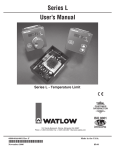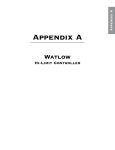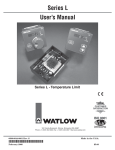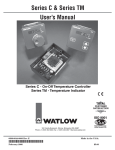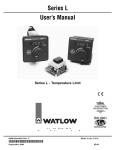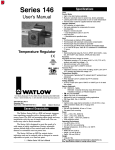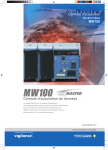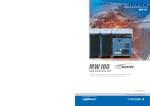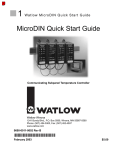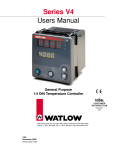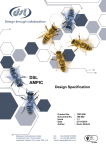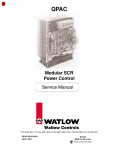Download User's Manual Series L
Transcript
Series L User’s Manual Series L - Temperature Limit TOTAL CUSTOMER SATISFACTION 3 Year Warranty ISO 9001 Registered Company 1241 Bundy Boulevard., Winona, Minnesota USA 55987 Phone: +1 (507) 454-5300, Fax: +1 (507) 452-4507 http://www.watlow.com 0600-0044-0001 Rev. H February 2015 Winona, Minnesota USA Made in the U.S.A. Safety Information We use note, caution and warning symbols throughout this book to draw your attention to important operational and safety information. A “NOTE” marks a short message to alert you to an important detail. ç CAUTION or WARNING Ó Electrical Shock Hazard CAUTION or WARNING A “CAUTION” safety alert appears with information that is important for protecting your equipment and performance. Be especially careful to read and follow all cautions that apply to your application. A “WARNING” safety alert appears with information that is important for protecting you, others and equipment from damage. Pay very close attention to all warnings that apply to your application. The safety alert symbol, ç (an exclamation point in a triangle) precedes a general CAUTION or WARNING statement. The electrical hazard symbol, Ó (a lightning bolt in a triangle) precedes an electric shock hazard CAUTION or WARNING safety statement. Technical Assistance If you encounter a problem with your Watlow controller, review your configuration information to verify that your selections are consistent with your application: inputs, outputs, alarms, limits, etc. If the problem persists, you can get technical assistance from your local Watlow representative (see back cover), by e-mailing your questions to [email protected] or by dialing +1 (507) 494-5656 between 7 a.m. and 5 p.m., Central Standard Time (CST). Ask for for an Applications Engineer. Please have the following information available when calling: • Complete model number • System wiring information • Series L Limit User’s Manual Warranty These controllers are manufactured by ISO 9001-registered processes and are backed by a three-year warranty. Return Material Authorization (RMA) 1. Call Watlow Customer Service, (507) 454-5300, for a Return Material Authorization (RMA) number before returning any item for repair. We need this information: • Ship to address • Bill to address • Contact name• Phone number • Method of return shipment • Your P.O. number • Detailed description of the problem • Any special instructions • Name and phone number of person returning the product. 2. Prior approval and an RMA number, from the Customer Service Department, is needed when returning any unused product for credit. Make sure the RMA number is on the out side of the carton, and on all paperwork returned. Ship on a Freight Prepaid basis. 3. After we receive your return, we will examine it and try to verify the reason for the return. 4. In cases of manufacturing defect, we will enter a repair order, replacement order or issue credit for material returned. 5. To return products that are not defective, goods must be be in new condition, in the origi- nal boxes and they must be returned within 120 days of receipt. A 20 percent restocking charge is applied for all returned stock controls and accessories. 6. If the unit is not repairable, it will be returned to you with a letter of explanation. 7. Watlow reserves the right to charge for no trouble found (NTF) returns. The Series L Limit user’s manual is copyrighted by Watlow Electric Manufacturing, © February 2015 with all rights reserved. 1 Overview Series LF and LV Watlow's temperature limit controllers* provide an economical limit controller solution for applications where thermal system protection is needed. A limit controller is added to applications to prevent over or under temperature conditions. The limit provides safety assurances against instances where a thermal runaway condition occurs as a result of a failed sensor, controller or output device. The LF and LV limit controllers are recommended for any application where thermal system runaway could result in large product scrap costs, damage to system equipment, potential fire hazard or risk to personnel. Both controllers are Factory Mutual and CSA approved. The LF and LV controllers are available with or without an operator interface and can be ordered in square 1/8th DIN panel mount, din rail mount, open board or potted module design configurations. Push-on, quick connect spade terminal or removable screw clamp style terminal block ordering options provide the electrical connections. The microprocessor design platform provides improvements in the performance, repeatability, and accuracy offered by Watlow's current line of basic control products. The Series LV includes an operator interface to allow viewing and selection of the limit set point. A red four character, seven-segment LED displays the limit set point. The limit set point selection is made with a continuous turn, velocity-sensitive rotary encoder. Push-toSet operation reduces accidental limit set point adjustments. Limit set point operating range temperature values are customer definable in the product configuration part number. The Series LF offers fixed limit set points. These units are supplied without an operator interface. Limit set point temperature values are customer definable in the product configuration part number. The features and performance of the LF and LV controllers make them ideally suited for a wide range of industrial limit control applications in the food preparation, industrial machinery, packaging and plastic markets. II with Class B Software review. It provides increased safety due to the use of Factory fixed set point, Factory fixed hysteresis and the use of redundant temperature sensors to protect against a single point sensor failure. Either sensor can initiate an over temperature limit condition along with a deviation between sensors greater than the process comparison value. The unit cannot be reset until both sensors are below the Limit Temperature minus the hysteresis value. A power cycle is then needed to reset the control. Definitions under UL/EN 60730-1 , 60730-2-9 Protective - Intended to provide safety or protective functionality. A control the operation of which is intended to prevent a hazardous situation during abnormal operation of the equipment Type 2 Action - Calibration Verification Testing or Functionality Verification testing conducted. A Type ".B" control has been investigated for "microdisconnection" applications. Disconnection of any pole (ungrounded conductor is not specified) for functional purposes. A Type ".K" control is designed that in the event of a break in the SENSING ELEMENT, or in any other part between the SENSING ELEMENT and the SWITCH HEAD, the declared disconnection is provided before the declared OPERATING VALUE , OPERATING TIME or OPERATING SEQUENCE is exceeded. THERMAL CUT-OUT - UL60730 Par 2.2.8. A Temperature Cut-out in accordance with UL60730 is defined as temperature sensing control intended to keep a temperature below or above one particular value during abnormal operating conditions and which has no provision for setting by the user. A UL60730 THERMAL CUT-OUT is similar to a UL873 Temperature Limiting control. Class B - software that includes code intended to prevent unsafe state in appliance. All Watlow Series L limit controllers include industryleading service, support and a 3-year warranty. *Also available, Series C, an on-off temperature controller version. Series LS This control meets the newest safety standard requirements for the food service industry UL/EN 60335 equipment. It is approved to UL/EN 60730-1 and 60730-2-9 Electronic Control Thermal Cut-out Class Watlow Ser ies L • 1 • Chapter 1: Over view LV and LF Features and Benefits Four-Character LED Display • Improves limit set point adjustment accuracy. Fixed or Adjustable Limit Set Points • Tamper proof operation. • Control flexibility. Set Point Adjustment Opetions • Rotary encoder. • Tactile increment and decrement keys. Push to Set • Reduce accidental limit set point adjustments. Multiple Mounting Options • Minimizes installation time. High or Low Limit Operation • Application flexibility. Fahrenheit or Celsius Operation with Indication • Application flexibility. Sensor Break Protection • Provides positive system shutdown. Agency Approvals • Meets requirements for agency certification. • NEMA 4X/IP65 seal panel mount versions available. • W.E.E.E.; CE; RoHS Micro Processor Based Technology • Accurate and repeatable protection. Stock to Four-Day Delivery LS Features and Benefits Dual channel sensors • Detects sensor faults • Fault tolerant design • Firmware review • Sensor deviation error, sensor placement errors Fail Safe Design • Internal or external faults cause product to shutdown in a safe manner Watlow Ser ies L • 2 • Chapter 1: Over view 2 Installation Installing the Open Board Controller (LF and LV) 61.7 mm (2.43 in) 61.7 mm (2.43 in) 45.07 mm (1.775 in) 56.3 mm (2.22 in) 61.7 mm (2.43 in) 45.07 mm (1.775 in) 56.3 mm (2.22 in) SWDC+ .6 N.O. 55.9 mm (2.20 in) 61.7 mm (2.43 in) SWDC- .7 COM 55.9 mm (2.20 in) N.C. .8 L2 .9 L1 .10 Terminal Designation Sticker Use M2.5 (#4) mounting hardware, not included Terminal Designation Sticker Use M2.5 (#4) mounting hardware, not included Screw Terminal Model Spade Terminal Model Figure 3a 1. Locate and drill four 3.2 mm (0.125 in) holes in the desired panel location. See Figure 3a for hole locations. 2. Mount the controller using four M2.5 (#4) screws. Installing the Potted Controller (LF, LV) (LS) Terminal Designation Sticker 70.1 mm (2.76 in) 46.6 mm (1.84 in) 70.1 mm (2.76 in) 35.1 mm (1.38 in) 35.1 mm (1.38 in) 35.1 mm (1.38 in) 35.1 mm (1.38 in) Range Limit LED 102.9 mm (4.05 in) 102.9 mm (4.05 in) 88.9 mm (3.50 in) 88.9 mm (3.50 in) Terminal Designation Sticker Terminal Designation Sticker Terminal Designation Sticker Use [3.5M] #6 hardware, not included Use [3.5M] #6 hardware, not included Figure 3b 1. Drill two 5 mm (0.187 in) diameter holes in the desired panel location. See Figure 3b for hole locations. 2. Mount the controller using two M3.5 (#6) screws. Watlow Ser ies L • 3 • Chapter 2: Installation Installing the DIN Rail Mount Controller 94.7 mm (3.73 in) 78.1 mm (3.08 in) 90.7 mm (3.57 in) 39.1 mm (1.54 in) 81.8 mm (3.22 in) To install or remove, press down here. See Installing/ Removing the DIN Rail Controller procedures below. Part Number Label 80.0 mm (3.07 in) DIN rail, upper mounting clip 101.6 mm (4.00 in) 80.3 mm 112.3 mm (3.16 in) (4.42 in) 1. SW-1 2. SW-2 35 mm x 7.5 mm DIN rail is not included with the assembly 3.TC-/S1 4.TC+/S2 5. S3 Terminal Designation Sticker Agency Label Panel mounting the bracket requires two M3.5 (#6) screws, not included To install, press in here. To remove, pull out here. See Mounting/Removing the DIN Rail Controller procedures below. Spade Terminal Model Screw Terminal Model Tactile Key Model Figure 4a 3. Remove the DIN rail bracket from the DIN rail. Sub-Panel Mounting 4. Insert a flat blade screwdriver between the DIN rail bracket and the case. Rotate the screwdriver to release the DIN rail bracket hooks from the ridges on the case, while firmly pushing the controller out the front of the DIN rail bracket. Alternate back and forth between the top and then the bottom. Be sure to support the controller as it comes out of the bracket. See Figure 4b. 1. Using the controller as a location template, mark both mounting holes. 2. Drill and tap two 2.7 mm (0.106 in) diameter holes in the desired panel location. See Figure 4a above for hole locations. 3. Mount the controller using two M3.5 (#6) screws. DIN Rail Mounting 1. Place the DIN rail upper mounting clip on the top edge of the DIN rail. See Figure 4a. DIN rail spec, DIN 50022, 35 mm x 7.5 mm (1.38 in x 0.30 in). 2. Press down firmly on the top back edge of the DIN rail bracket and push in on the bottom, front edge of the bracket. The controller snaps securely onto the rail. See Figure 4a. If the controller does not snap on, check to see if the DIN rail is bent. Minimum clipping distance is 34.8 mm (1.37 in), the maximum is 35.3 mm (1.39 in). Press forward with thumb. Removing the DIN Rail Controller 1. Remove power from the system. Insert flat blade screwdriver here. 2. Remove all the wiring connections from the back of the controller. 3. While pressing down on the top, back edge of the DIN rail bracket, pull forward on the bottom, front edge of the DIN rail bracket. See Figure 4a. Figure 4b çCaution: FM approval requires limit switches to be suitably enclosed to restrict casual user adjustment. Removing the Controller from the DIN Rail Bracket 1. Remove power from the system. 2. Remove all the wiring connections from the back of the controller. Watlow Ser ies L • 4 • Chapter 2: Installation 72.4 mm (2.85 in) 68.0 mm (2.68 in) Panel Cutout Panel Thickness 1.52 to 3.18 mm (0.060 to 0.125 in) 72.4 mm (2.85 in) 68.0 mm (2.68 in) 19.1 mm (0.75 in) minimum 19.1 mm (0.75 in) minimum Spade Terminal Model Customer Front Panel Part Number Label 84.5 mm square (3.33 in) Terminal Blocks Locations on Screw Terminal Models Mounting Bracket 6.4 mm (0.25 in) Tactile Key, Screw Terminal Model 19.2 mm (0.76 in) 51.7 mm (2.04 in) Spade Terminal Model installation. See Figure 4. Slide the collar firmly against the back of the panel, getting it as tight as possible. To ensure a tight seal, use your thumb to lock the tabs into place while pressing the case from side to side. Don’t be afraid to apply enough pressure to install the controller. The tabs on each side of the collar have teeth that latch into the ridges. Each tooth is staggered at a different height, so only one of the tabs on each side are ever locked into the ridges at a time. Confirm that the tabs on one side of the collar correspond with those on the opposite side. Make sure the two corresponding tabs are the only ones locked in the ridges at the same time. If the corresponding tabs are not supporting the case at the same time, you will not have a NEMA 4X seal. Figure 5 Installing the Square 1/8 DIN Panel Mount Controller 1. Make the panel cutout using the mounting dimensions above. 2. Remove mounting bracket from the back of the controller. 3. If your controller has a gasket, check to see that the gasket is not twisted, and is seated within the case bezel flush with the panel. Place the case in the cutout. Make sure the gasket is between the panel cutout and the case bezel. 4. While pressing the front of the case firmly against the panel, slide the mounting collar over the back of the control. The tabs on the collar must line up with the mounting ridges on the case for secure Watlow Ser ies L Screw Terminal Models Contact your local Greenlee supplier for the appropriate punch kit and cutout tool for rapid mounting. 5. Insert the control chassis into its case and press the bezel to seat it. Make sure the inside gasket • 5 • Chapter 2: Installation is also seated properly and not twisted. The hardware installation is complete. Proceed to the wiring section. 2. Insert the controller into the panel cutout. 3. While pressing the bezel firmly against the panel, slide the mounting bracket over the back of the controller. Be sure the levers on the mounting bracket line up with the teeth on the case. 4. Press the bracket up to the back of the panel. The controller should fit tightly in the panel cutout. Removing the Panel Mount Square 1/8 DIN Controller 1. Remove power from the system. 2. Remove all the wiring connections from the back of the controller. 3. Slide a thin, wide tool (putty knife) under all three mounting tabs, top then bottom, while pushing forward on the back of the case. Be ready to support the controller as it slides out of the panel cutout. çCaution: FM approval requires limit switches to be suitably enclosed to restrict casual user adjustment. Watlow Ser ies L • 6 • Chapter 2: Installation 3 Wiring Ó Warning: Use National Electric (NEC) or other country-specific standard wiring and safety practices when wiring and connecting this controller to a power source and to electrical sensors or peripheral devices. Failure to do so may result in damage to equipment and property, and/or injury or loss of life. Note: Insulated terminals required for quick connect style terminals. For quick connect terminals 1, 2, 6, 7, 8, 9, and 10, AMP P/N 3-520406-2 or equivalent recommended. Use Amp crimp tool P/N 58078-3, insert 903913. For quick connect terminals 3, 4, and 5, AMP P/N 2-520405-2 or equivalent recommended. Amp crimp tool P/N 58078-3, insert 58079-3. ç Caution: FM approval requires limit switches to be suitably enclosed to restrict casual user adjustment. The terminals on the back of the Series L limit controllers are the same for all of the package styles. They are 6.3 mm (0.25 in) quick connect, push on style terminals or removable screw terminal block. The terminal style is an ordering option. Check the part number to determine your hardware configuration. Refer to the wiring diagrams appropriate for your controller’s configuration. All outputs are referenced to a de-energized state. Wiring Guidelines 1. Use the correct thermocouple type per the model number on the case sticker of the unit. See dimension drawings for sticker locations. • Use correct thermocouple polarity. Red is usually negative. • If you must extend thermocouple leads, use thermocouple extension wire to minimize errors. • Be sure you have good crimp connections on all wire connections. • Insulate the thermocouple mounting from the mounting surface to prevent heat migration input errors. • Thermocouple leads should be routed s eparately from any high voltage lines. • Long lead lengths create electrical resistance. When using a two-wire RTD, there will be an additional 2.6° C (4.7° F) error for every 1Ω of lead length resistance. That resistance when added to the resistance of the RTD element, can result in erroneous input to the temperature controller. 2. In electrically-noisy environments (heavy switching contactors, motors, solenoids, etc.), use shielded thermocouple lead wire with the shield connected at the sensor end only. 3. Use a separate thermocouple to maintain the limit function of this controller; do not parallel thermocouple input from the primary controller. 4. All wiring and fusing must conform to the National Electric Code (NEC) NFPA70 and any other locally applicable codes. 5. Fuse the independent load voltage on the L1 (hot) side and connect it to the common (C) side of the relay. Note: The model number determines the number of connections and terminal style. See below for terminal locations. LF/LV 1 2 3 4 5 1 2 6 7 8 9 10 3 4 5 6 7 8 9 10 LED LS Watlow Ser ies L • 7 • Limit Range Chapter 3: Wir ing (LF, LV) (LS) - Nominal voltage options: • 24VÅ (ac) +10%; -15% • 100 to 240VÅ (ac) ± 10% • 120VÅ (ac) +10%; -15% • 50/60 Hz ±5% • 230 to 240VÅ (ac) +10%; -15% • 50/60 Hz, ±5% 1 2 6 7 3 8 4 5 Ó WARNING: If high voltage is applied to a low-voltage controller, irreversible damage will occur. Note: Insulated terminals required for quick connect style terminals. For quick connect terminals 1, 2, 6, 7, 8, 9, and 10, AMP P/N 3-520406-2 or equivalent recommended. Use Amp crimp tool P/N 58078-3, insert 903913. 9 L2 10 L1 L2 L1 Figure 8b — Thermocouple Input Thermocouples are polarity sensitive. The negative lead (usually red) must be connected to the negative thermocouple terminal. • Input impedance: >10 MΩ (LF, Thermocouple Thermocouple + For quick connect terminals 3, 4, and 5, AMP P/N 2-520405-2 or equivalent recommended. Amp crimp tool P/N 58078-3, insert 58079-3. - Nominal voltage options: LED Warning: Use National Electric (NEC) or other country-specific standard wiring and safety practices when wiring and connecting this controller to a power source and to electrical sensors or peripheral devices. Failure to do so may result in damage to equipment and property, and/or injury or loss of life. Figure 8a — AC Power Wiring Range Limit ç LV) 1 2 (LS) 6 7 3 4 5 8 Thermocouple2 + 9 Thermocouple2 - 10 Thermocouple1 Thermocouple1 + Figure 8c — RTD Input (100 Ω Platinum DIN curve 0.00385 Ω/Ω/°C) • Terminals S2 and S3 must be shorted for a two-wire RTD • Nominal excitation current: 125 µA 3-Wire RTD* 2-Wire RTD RTD S1 RTD S1 RTD S2 RTD S3 RTD S2 S3 1 2 S1 3 S2 4 S3 5 6 7 8 9 10 *No lead resistance compensation Watlow Ser ies L • 8 • Chapter 3: Wir ing ç Figure 9a — External Reset Switch • Momentary normally open (N.O.), dry contact closure Warning: Use National Electric (NEC) or other countryspecific standard wiring and safety practices when wiring and connecting this controller to a power source and to electrical sensors or peripheral devices. Failure to do so may result in damage to equipment and property, and/or injury or loss of life. Note: To reset the LS controller, cycle input power to the controller. Note: Use of an external reset switch may affect FM approval. Only the use of a momentary N.O. switch is valid for approval. Figure 9b - Form C Mechanical Relay Output (LF/LV only) Note: Insulated terminals required for quick connect style terminals. For quick connect terminals 1, 2, 6, 7, 8, 9, and 10, AMP P/N 3-520406-2 or equivalent recommended. Use Amp crimp tool P/ N 58078-3, insert 90391-3. For quick connect terminals 3, 4, and 5, AMP P/N 2-520405-2 or equivalent recommended. Amp crimp tool P/N 58078-3, insert 58079-3. Momentary N.O. Switch (customer supplied) SW-1 SW-2 6 7 3 8 4 5 9 10 • Form C contacts • 8 A, resistive Customer supplied Quencharc for pilot duty, inductive loads only. See note. • 250 VA pilot duty, 120/240VÅ (ac), inductive • 240VÅ (ac) maximum • 30VÎ (dc) maximum • See Quencharc note • For use with ac or dc External Load 1 2 6 N.O. Normally Open C Common 7 N.C. Normally Closed 8 3 4 5 • Minimum load current 100 mA L2 L1 9 Mechanical Relay 10 N.O. COM. N.C. • Output does not supply power Internal Circuitry Figure 9c - Form A Mechanical Relay Output (LS only) • Form A contact • 8 A, resistive • 120 VA pilot duty, 120/240VÅ (ac), inductive • Does not need Quencharc • Rated 6000 cycles Quencharc Note: Switching pilot duty loads (relay coils, solenoids, etc.) with the mechanical relay output option requires use of an R.C. suppressor. External Load N.O. Normally Open L2 Com Common L1 Mechanical Relay Watlow carries the R.C. suppressor Quencharc brand name, which is a trademark of ITW Paktron. Watlow Part No. 08040147-0000. Watlow Ser ies L 1 2 N.O. Com Internal Circuitry • 9 • Chapter 3: Wir ing LF/LV System Wiring Examples Power Disconnect Switch L1 120V~(ac) L2 Fuse Customer Supplied Quencharc Fuse Not used 1 2 Fuse High Limit Mechanical Contactor coil Fuse 6 SWDC+ SWDC7 8 L2 9 TC- 3 TC+ 4 5 10 Reset Switch (customer supplied) SW-1 SW-2 L1 + SSR-240-10A-DC1 in out Solid-State Relay - Series CV Temperature Controller CVB1JH00000100C 1 2 TC- N.O. COM 7 N.C. 8 L2 9 6 3 TC+ 4 5 L1 10 Heater Series LF Limit Control LFC4JW0120AAAAA Limit Sensor Process Sensor 120VÅ (ac) L1 L2 Series CV Temperature Controller CVB1JH00000100C Power Disconnect Switch 1 1 HighTemp. Light 3 2 4 (+) 3 5 (-) 10 L1 4 TC+ 3 TC- L2 9 SWDC+ 6 4 2 SWDC7 6 7 3 to 32 VÎ (dc) in (+) SSR-240-10A-DC1 Solid-State Relay (-) 1 CR-1 5 6 1 1 8 48 to 260 VÅ out 9 10 11 L1 7 8 9 14 (+) 10 15 (-) 11 12 13 1 4 TC+ Heater 10 2 L2 9 SW-1 1 SW-2 2 N.O. 6 N.C. 8 3 TC7 COM 17 13 16 18 Series LF Limit Controller LFC4JW0120AAAAA 2 12 1 CR R 2 2 High-Temperature Light Figure 10 — System Wiring Examples Watlow Ser ies L • 10 • Chapter 3: Wir ing LS System Wiring Examples Power Disconnect Switch L1 120V~(ac) L2 Fuse Customer Supplied Quencharc Fuse coil Not used 1 2 6 SWDC+ SWDC7 8 L2 9 TC- 3 TC+ 4 5 10 Fuse High Limit Mechanical Contactor Fuse SSR-240-10A-DC1 Solid-State Relay L1 + in out - Series CV Temperature Controller CVB1JH00000100C Normally Closed spring loaded push button for Limit reset N.O. COM Heater TC2 + L2 TC2 - L1 TC1 TC1 + Series LS Limit Control LSF4HW0900220AA Process Sensor Limit Sensors 120VÅ (ac) L1 L2 Series CV Temperature Controller CVB1JH00000100C Power Disconnect Switch 1 1 3 2 4 (+) 3 5 (-) 10 L1 4 TC+ 3 TC- SWDC+ 6 4 L2 9 SWDC7 6 (+) 2 7 3 to 32 VÎ (dc) in SSR-240-10A-DC1 Solid-State Relay (-) 1 CR-1 5 1 8 48 to 260 VÅ out 9 10 Heater 2 Normally Closed spring loaded push button for Limit reset 6 1 L1 11 7 TC2 + 8 TC2 - 9 10 TC1 + 12 Watlow Ser ies L 2 Series LS Limit Control LSF4HW0500220AA TC1 - 11 13 L2 1 COM 17 • 11 • N.O. 6 1 CR 2 Chapter 3: Wir ing 4 User Interface LV _ (1, 2, 5 or 6) _ _ _ _ _ _ _ _ _ _ A LIMIT LV LED Display: Indicates the limit set point. SET/RESET Key: Press and hold key to adjust the limit set point temperature. New limit set point is entered 3 seconds after the knob stops moving. Press key to reset latched limit output once tempera-ture is back in safe region. Can also be reset through customer supplied external reset switch. F C ALARM °F or °C Indicator Light: Lit to indicate if unit is configured for degrees Fahrenheit or degrees Celsius. ALARM Indicator Light: Lit when limit is tripped. Finger Tip Indent: Insert finger tip into indent for quick and easy set point changes. SET Limit Set Point Knob: To increase limit set point, turn knob clockwise. To decrease limit set point, turn knob counter-clockwise. The new set point is entered 3 seconds after the knob stops moving. Limit set point will not change unless SET/RESET key is pressed. RESET Figure 12 — Variable Limit Set Point, Standard Interface LV _ (A, B, C or D) _ _ _ _ _ _ _ _ _ _ A LIMIT LV F C LED Display: Indicates the limit set point. SET/RESET Key: Press and hold key to adjust the limit set point temperature. New limit set point is entered 3 seconds after the last key press. Press key to reset latched limit output once temperature is back in safe region. Can also be reset through customer supplied external reset switch. ALARM °F or °C Indicator Light: Lit to indicate if unit is configured for degrees Fahrenheit or degrees Celsius. ALARM Indicator Light: Lit when limit is tripped. Increment and Decrement Keys: Press the Up-Arrow key to increase the limit set point. Press the Down-Arrow key to decrease the limit set point. The new set point is entered 3 seconds after the last key press. The limit set point will not change unless the SET/RESET key is presses. SET RESET çCaution: FM approval requires limit switches to be suitably enclosed to restrict casual user adjustment. To adjust the Calibration Offset on models with tactile keys, first hold down both the Increment and Decrement keys for five seconds. The display will first show [`CAL] for five seconds, then it will display the Calibration Offset value. Adjust the value with the Increment and Decrement keys (range: -30 to 30°). The new value will take effect three seconds after the last key stroke. The display will blink, then return to the primary display after five seconds. Watlow Ser ies L To change the temperature units on models with tactile keys, first hold down both the Increment and Decrement keys for ten seconds. The display will show [F``C] for two seconds. Adjust the units with the Increment and Decrement keys. The new value will take effect three seconds after the last key stroke. The display will blink, then return to the primary display after five seconds. The set point value, process value and offset will automatically adjust to the new temperature scale. • 12 • Chapter 4: User Interface Troubleshooting Indication Possible Cause(s) Corrective Action On indicating limits, the display is not illuminated. • Power supply switch off • Fuse blown • Breaker tripped • Safety interlock door switch activated • Wiring incorrect or open • Power supply voltage incorrect • Defective limit • Turn switch on • Replace fuse (check cause of failure) • Reset breaker (check cause of failure) • Close door • Check wiring • Verify input power • Repair or replace limit Temperature reading is incorrect, showing a sensor error, [Er;In] , or ALARM LED is switching at the wrong temperature. • Setting for degree C or F is incorrect • Check the model part number for Degree C or F. If the model has Increment/Decrement keys, then the C/F setting is adjustable • Sensor or limit may be bad. Sensor connections may be bad • Place a jumper wire across the thermocouple input terminals. The display should indicate ambient temperature. If it does, the limit is OK - For high limit: Start with limit set point above ambient temperature, ALARM LED should be off. Decrease limit set point until ALARM LED goes on. It should be approximately ambient temperature - For low limit: Start with limit set point below ambient temperature, ALARM LED should be off. Increase limit set point until ALARM LED goes on. It should be approximately ambient temperature • Ambient temperature in the control cabinet is over 70°C • Measure temperature in cabinet to ensure it is below 70C. Vent cabinet or add fans if necessary • Ground loop problem. Can occur when using a switched DC output and a grounded thermocouple • Remove power from the system. Use an ohm meter to measure resistance between output DC- and the thermocouple sheath. If there is continuity, replace sensor with an ungrounded thermocouple Temperature seems to be decreasing, but actual process is increasing. • Thermocouple polarity is reversed. In the US, red wire insulation denotes the negative wire • Check thermocouple connections. All connections, including extension wire must maintain the correct polarity. Correct polarity problems Temperature seems to be reading low and not increasing while actual process temperature is increasing. • Sensor is bad. Thermocouple is shorted • Check thermocouple connections. Check thermocouple wire insulation to make sure it is not damaged, causing the wires to short (making a new junction) Temperature seems to be offset from actual process temperature, or the ALARM LED switches on at the wrong temperature. The offset changes with changes in process temperature. • Copper wire was used instead of thermocouple extension wire. Connectors of metals different than thermocouple metal were used to splice or make connections • Check thermocouple connections. Check to make sure that only thermocouple extension wire of the correct type was used to extend thermocouple leads. Replace if necessary Troubleshooting Thermocouple Inputs Watlow Ser ies L • 13 • Chapter 5: Troubleshooting Indication Possible Cause(s) Corrective Action LS Controller Both LED's alternate flashing. • Variance between sensors greater than • Ensure that temperature variance 20ºC or sensors are reversed between sensors remains within 20ºC • Verify sensor polarity is correct Troubleshooting RTD inputs Temperature reading is incorrect, showing a sensor error, [Er;In] , or ALARM LED is switching at the wrong temperature. • Setting for degree C or F is incorrect Check model part number for Degree C or F. If the model has Increment/ Decrement keys, then the C/F setting is adjustable • Sensor or limit may be bad. Sensor connections may be bad • Place a 110 ohm resistor across the sensor input terminals - For high limit: Start with limit set point above ambient temperature, ALARM LED should be off. Decrease limit set point until ALARM LED goes on. It should be approximately ambient temperature. If it does, the limit is OK. Sensor or connections may be bad - For low limit: Start with limit set point below ambient temperature, ALARM LED should be off. Increase limit set point until ALARM LED goes on. It should be approximately ambient temperature. If it does, the limit is OK. Sensor or connections may be bad • Ambient temperature in the control cabinet is over 70°C (158°F) • Measure temperature in cabinet to ensure it is below 70°C (158°F). Vent cabinet or add fans if necessary • Sensor connections may be bad. Exces- • Check sensor connections. Measure sive lead wire resistance lead wire resistance. There will be a 2.6C (4.7°F) error for every ohm of lead wire resistance Troubleshooting limit outputs ALARM is not tripped when it • Temperature appears to be incorrect. See input troubleshooting should be. ALARM LED is not on (relay is energized in safe • Limit set point is not set correctly condition, N.O. contact is closed and N.C. contact is open). • See input troubleshooting ALARM is tripped when it should not be. ALARM LED is on (relay is de-energized in limit condition, N.O. contact is open and N.C. contact is closed). • Limit output is tripped (latched) • Press RESET key to reset limit. • Output wiring is incorrect • Verify wiring. Relay outputs act as a switch, they do not source power • Temperature appears to be incorrect, see input troubleshooting • See input troubleshooting • Limit set point is not set correctly • Verify limit set point setting • Limit output is defective • Repair or replace limit • Temperature reading is incorrect on display of indicating controls or limit, see input troubleshooting • See input troubleshooting • Set point is not set correctly • Verify limit set point setting Limit output signal is on when it should not be on. Load LED is on. Watlow Ser ies L • 14 • • Verify limit set point setting Chapter 5: Troubleshooting Indication Possible Cause(s) Corrective Action Limit load is on when it should • Power switching device (mechanical relay, contactor, etc.) is shorted. Limit be off. ALARM LED is off. output shorted. • Output wiring is incorrect. • Remove wires from output of limit to input of power switching device. If load is still on, replace power switching device. If load turns off, replace limit or sensor. See input troubleshooting • Verify wiring LS Controller Unable to reset controller after the limit trips, Limit LED flashing, Range LED on. • Temperature above Limit Set Point Hysteresis Value • Wait until temperature returns to safe range • If temperature within safe range power must be removed from the controller for no less than 3 seconds LS LED Definition Limit Range LED Status Flashing Off Limit Range Limit Relay Off (open) Limit Condition - Temperature > Limit set point or above Reset point. Flashing On Off (open) Limit Condition - Temperature < Reset point, but reset not yet enabled. Limit Range Off On On (closed) Temperature < Limit Set Point “Normal Operation” Limit Range Flashing Flashing Off (open) Ambient Alarm 85ºC Limit Range Alternate Flashing Off (open) Health Check Error Watlow Ser ies L • 15 • Chapter 5: Troubleshooting Specifications Controller • Microprocessor based, limit controller • Nominal switching hysteresis, typically 1.7°C (3°F) - Model LS customer defined, model number dependent • High or low limit, factory selectable -Model LS high limit only • Latching output requires manual reset upon over or under temperature condition - Model LS high limit only with automatic reset on power loss only • Manual or automatic reset on power loss, factory selectable - Model LS automatic reset on power loss only • Internal front panel or external customer supplied momentary reset switch (LF/LV only) • Input filter time: 1 second Operator Interface (model dependent) • Four digit , 7 segment LED displays, .28" high (not available on model LS) • °F or °C indicator LED • ALARM indicator LED • Continuous turn, velocity sensitive rotary encoder for limit set point adjustment • Front panel SET/RESET key on variable set point models • No operator interface on fixed set point models Standard Conditions For Specifications • Rated line voltage, 50 to 60Hz, 0 to 90% RH noncondensing, 15-minute warm-up Calibration ambient range: 25°C (77°F) ±3°C Sensor Input Thermocouple • Grounded or ungrounded - Model LS ungrounded only • Type E, J, K, T thermocouple types - Model LS type J and K only • >10 MΩ input impedance • 250 nV input referenced error per 1 Ω source resistance RTD (LF/LV only) • 2-wire platinum, 100 Ω • DIN curve (.00385 curve) • 125 µA nominal RTD excitation current Input Accuracy Span Range Thermocouple Input Type E -200 to 800°C or -328 to 1,470°F Type J: 0 to 750°C or 32 to 1,382°F Model LS -18 to 406°C or 0 to 764°F Type K: -200 to1,250°C or -328 to 2,282°F Model LS -18 to 537°C or 0 to 999°F Type T: -200 to 350°C or -328 to 662°F RTD (DIN):-200 to 800°C or -328 to 1,472°F • Calibration accuracy: ±1% of input accuracy span, ±1° at standard conditions and actual calibration ambient Exception: Type T, ±2.4% of input accuracy span for -200 to 0°C (-328 to 32°F) Watlow Ser ies L • Temperature stability: ±0.3 degree per degree change in ambient • LS models, ± 6°C accuracy RTD Input • Calibration accuracy: ±1% of input accuracy span ±1° at standard conditions and actual calibration ambient • Temperature stability: ±0.2 degree per degree change in ambient Allowable Operating Ranges Type E -200 to 800°C or -328 to 1,470°F Type J: -210 to1,038°C or -346 to 1,900°F Model LS 0 to 330°C or 32 to 626°F Model LS -18 to 406°C or 0 to 764°F Type K: -270 to1,370°C or -454 to 2,500°F Model LS 0 to 438°C or 32 to 820°F Type T: -270 to 400°C or -454 to 750°F RTD (DIN):-200 to 800°C or -328 to 1,472°F External Reset Switch (LF/LV only) • Momentary, dry contact closure. See wiring section Output Types Electromechanical Relay, Form C (LF/LV only) • Minimum load current: 100 mA • 8 A @ 240VÅ (ac) or 30VÎ (dc) maximum, resistive. • 250 VA pilot duty, 120/240VÅ (ac) maximum, inductive • Use RC suppression for inductive loads • Electrical life 100,000 cycles at rated current Electromechanical Relay, Form A (LS only) • Minimum load current: 100 mA • 8 A resistive load • 120 VA pilot duty, 120/240VÅ (ac) maximum, inductive • Electrical life 6,000 cycles at rated current Agency Approvals Series LF (potted version only) • UL 991 recognized temperature limit for food service industry • RoHS Directive (2002-95-EC) Series LV and Series LF (including potted version) • UL 873 recognized temperature regulator. File #E43684 • UL 197 reviewed for use in food service appliances. • ANSI Z21.23 Gas appliance thermostat approval. • CSA C22.2#24 approved temperature control. File #30586 • FM Class 3545 temperature limit switches. File #3017239 • NEMA 4X/IP65 on panel-mount versions with tactile keys for set point adjustment • W.E.E.E.; CE - see Declaration of Conformity • RoHS Directive (2002-95-EC) Series LS (potted version only) • UL/EN 60730-1, Type 2, B, K Automatic Electronic Controls for household and similar use • UL 1998 Software review Class B • Sensor differential - 20°C / 36°F • Thermal Limit • 16 •Appendix Terminals • 6.4 mm (0.25 in) quick connect, push-on terminals. See order options. Refer to Wiring section for crimp-on terminal recommendations • Removable screw clamp style terminal blocks. See order options • Wire gauge 0.1 to 4 mm2 (30 to 12 AWG). Strip length, 8 mm (0.30 in) • Torque: 0.8 Nm (7 in-lb) maximum Power •24VÅ (ac) +10%; -15%; 50/60 Hz, ±5% • Model LS 100 - 240VÅ (ac) +10%; -15%; 50/60 Hz, ±5% •120VÅ (ac) +10%; -15%; 50/60 Hz, ±5% • 208 to 240VÅ (ac) +/-10%, Series LF and CF only • 230 to 240VÅ (ac) +10%; -15%; 50/60 Hz, ±5% • 10VA maximum power consumption. • Data retention upon power failure via nonvolatile memory. Operating Environment • 0 to 70°C (32 to 158°F) • 0 to 90% RH, non-condensing. • Storage temperature: -40 to 85°C (-40 to 185°F) Dimensions • DIN Rail model can be DIN rail or chassis mount DIN rail spec, DIN 50022, 35 mm x 7.5 mm (1.38 in x 0.30 in) Style Width Height Depth Open board 61.7 mm (2.43 in) 61.7 mm (2.43 in) 45.1 mm (1.78 in) All Potted Versions 70.1 mm (2.76 in) 102.9 mm (4.05 in) 46.6 mm (1.84 in) DIN Rail 78.1 mm (3.08 in) 112.3 mm (4.42 in) 90.7 mm* (3.57 in) Square 1/8DIN Panel 72.4 mm (2.85 in) 72.4 mm (2.85 in) Behind panel Glossary automatic power reset — A feature in latching limit controllers that does not recognize power outage as a limit condition. When power is restored, the output is re-energized automatically, as long as the t emperature is within limits. latched output — Limit control output latches in deenergized c ondition when over or under temperature condition occurs and cannot be reset unless temperature drops below set point. limit or limit controller (LF/LV) — A highly reliable, discrete safety device (redundant to the primary controller) that monitors and limits the t emperature of the process or a point in the process. When t emperature exceeds or falls below the limit set point, the limit controller interrupts power through the load circuit. A limit controller can protect equipment and people when it is correctly installed with its own power supply, power lines, switch and sensor. manual power reset — A feature in latching limit controllers that does recognize power outage as a limit condition. When power is restored, the output is not reenergized automatically, even if the process is within limits. An operator must use the reset key or switch to manually re-energize the output on power up. manual reset — A feature on a limit controller that requires human intervention to return the limit to normal operation after a limit c ondition has occurred. safety limit (LS) — An automatic limit intended for use in applications where an over-temperature fault may cause a fire. 51.7 mm (2.04 in) *Depth including DIN rail, 94.7 mm (3.73 in) Note: These specifications are subject to change without prior notice. Watlow Ser ies L • 17 •Appendix LF Ordering Information and Model Numbers Limit Control no user interface L F _ _ _ _ _ _ _ _ A A A A _ Set Point Type F Fixed Limit Set Point Line Voltage C 120VÅ (ac) E 230 to 240VÅ (ac) G 24VÅ (ac) Controller Package 1 Panel Mount, Square 1/8 DIN, Spade Terminals 2 DIN Rail Mount, Spade Terminals 3 Open Board, not potted, Spade Terminals 4 Potted Case, Spade Terminals 5 Panel Mount, Square 1/8 DIN, Screw Terminals 6 DIN Rail Mount, Screw Terminals 7 Open Board, not potted, Screw Terminals Sensor and Sensor Operating Range H Type J -346 to 1,900°F J Type J -210 to 1,038°C K Type K -454 to 2,500°F L Type K -270 to 1,370°C M Type T -454 to 750°F N Type T -270 to 400°C P 100 Ω RTD -328 to 1,472°F R 100 Ω RTD -200 to 800°C S Type E -328 to 1,470°F T Type E -200 to 800°C Limit Type U High Limit, External manual reset on power up, external manual reset on over temperature W High Limit, Auto reset on power up, external manual reset on over temperature Y Low Limit, External manual reset on power up, external manual reset on under temperature Z Low Limit, Auto reset on power up, external manual reset on under temperature Fixed Limit Set Point Value * XXXX Limit Set Point Value** Overlay/Custom Option A Standard *Note: Limit set point must fall within the sensor operating range. **Note: A (-) is used in the left digit of the operating range to indicate negative values. Watlow Ser ies L • 18 •Appendix LV Ordering Information and Model Numbers Limit Control, LED display, front panel reset switch L V _ _ _ _ _ _ _ _ _ _ _ _ _ Set Point Type V Variable Limit Set Point Line Voltage C 120VÅ (ac) E 230 to 240VÅ (ac) G 24VÅ (ac) Controller Package 1 Panel Mount, Square 1/8 DIN, Rotary Knob, Spade Terminals 2 DIN Rail Mount, Rotary Knob, Spade Terminals 5 Panel Mount, Square 1/8 DIN, Rotary Knob, Screw Terminals 6 DIN Rail Mount, Rotary Knob, Screw Terminals A NEMA 4X/IP65, Panel Mount, Tactile Keys, Spade Terms B DIN-rail Mount, Tactile Keys, Spade Terminals C NEMA 4X/IP65, Panel Mount, Tactile Keys, Screw Terms D DIN-rail mount, Tactile Keys, Screw Terminals Sensor and Sensor Operating Range H Type J -346 to 1,900°F J Type J -210 to 1,038°C K Type K -454 to 2,500°F L Type K -270 to 1,370°C M Type T -454 to 750°F N Type T -270 to 400°C P 100 Ω RTD -328 to 1,472°F R 100 Ω RTD -200 to 800°C S Type E -328 to 1,470°F T Type E -200 to 800°C Limit Type U High Limit, Manual Reset on power up, manual reset on over temperature W High Limit, Auto Reset on power up, manual reset on over temperature Y Low Limit, Manual Reset on power up, manual reset on under temperature Z Low Limit, Auto Reset on power up, manual reset on under temperature Low Limit Set Point Range Limit* XXXX Low Limit Set Point Operating Range Value** High Limit Set Point Range Limit* XXXX High Limit Set Point Operating Range Value Overlay/Custom Option A Standard *Note: Set point ranges must fall within the sensor operating range. **Note: A (-) is used in the left digit of the operating range to indicate negative values. Watlow Ser ies L • 19 •Appendix LS Ordering Information and Model Numbers Limit Control L S _ _ _ _ _ _ _ _ _ _ _ _ _ Series LS S Saftey Limit Set Point F Fixed Set Point Package 4 Potted case, spade terminals Sensor Type and Scale H TC Type J Fahrenheit (32 to 626°F) J TC Type J Celsius (0 to 330°C) K TC Type K Fahrenheit (32 to 820°F) L TC Type K Celsius (0 to 438°C) Limit Type W High limit, power cycle to reset High Set Point Temperature Value XXXX A zero (0) is used in the left most digit of the set point Hysteresis XXX The temperature differential below the limit set point at which a reset is possible. Limit High Set Point - Hysteresis must be greater than or equal to the Low Sensor Range. Custom Options AA Standard Watlow Ser ies L • 20 •Appendix Declaration of Conformity Series L WATLOW Electric Manufacturing Company ISO 9001 since 1996. 1241 Bundy Blvd. Winona, MN 55987 USA Declares that the following product: Designation: Series L Model Numbers: LF (C, E or G)(1, 2, 3, 4, 5, 6 or 7)(any letter)(U, W, Y or Z) (#### or –###) (AAAA) X LV (C, E or G)(1, 2, 5 or 6)(any letter)(U, W, Y or Z) (#### or –###) (####) X LSF4 (H, J, K or L) W (#### indicating Limit trip point) (### indicating hysteresis) XX Where X = Any number or letter, and # = Any number Classification: Series LF, LV Temperature Regulator, Front panel IP20, IP65 optional Series LS, Electronic Temperature Limiter with Protective Function Software Class B, Output Type 2.B.K IP10 All – Installation Category II, Pollution Degree 2 Incorporated equipment Rated Voltage: LF, LV 24 V, 100 to 120 V, 200 to 240 V~ (ac), 50/60 Hz LS, 100 to 240 V~(ac) 50/60 Hz Rated Power Consumption: 10 VA maximum Meets the essential requirements of the following European Union Directives by using the relevant standards show below to indicate compliance. 2004/108/EC Electromagnetic Compatibility Directive EN 61326-1:2013 EN 60730-1:2011 EN 60730-2-9:2010 EN 61000-4-2:2009 EN 61000-4-3:2010 EN 61000-4-4:2012 EN 61000-4-5:2006 EN 61000-4-6:2014 EN 61000-4-8:2010 EN 61000-4-11:2004 EN 61000-4-28:2009 EN 61000-3-2:2009 EN 61000-3-3:2013 SEMI F47:2000 LF, LV LS LS LS EN 60730-1:2011 LS EN 60730-2-9:2010 EN 61010-1:2011 LF, LV Electrical equipment for measurement, control and laboratory use – EMC requirements, Industrial Immunity, Class B Emissions. Automatic electric controls for household and similar use: Particular requirements for temperature sensing controls, Class B Emissions. Electrostatic Discharge Immunity Radiated Field Immunity Electrical Fast-Transient / Burst Immunity Surge Immunity (Reviewed to IEC 61000-4-5 2014) Conducted Immunity Magnetic Field Immunity Voltage Dips, Short Interrupts and Variations – Immunity Variation of power frequency immunity – Level 2 Harmonic Current Emissions (Reviewed to IEC 61000-3-2 2014) Voltage Fluctuations and Flicker Specification for Semiconductor Sag Immunity Figure R1-1 2006/95/EC Low-Voltage Directive Automatic electric controls for household and similar use: Particular requirements for temperature sensing controls. Safety Requirements of electrical equipment for measurement, control and laboratory use. Part 1: General requirements Compliant with 2011/65/EU RoHS Directive Per 2012/19/EU WEEE Directive Please Recycle Properly Joe Millanes Winona, Minnesota, USA Director of Operations January 2015 Name of Authorized Representative Title of Authorized Representative Place of Issue Date of Issue Signature of Authorized Representative Watlow Ser ies L • 21 •Appendix























